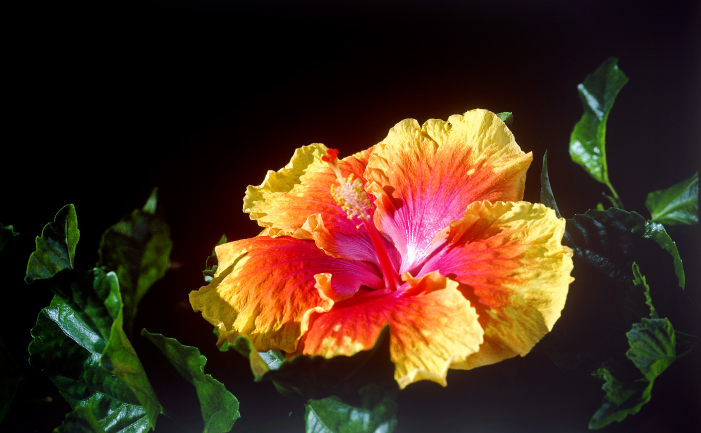The Hibiscus
Although widely known as Hawaiian hibiscus, Hibiscus rosa-sinensis was probably native to Southern China and south-east Asia, then spread to the Pacific Islands long before Europeans reached that part of the world. Today it is very popular as an ornamental plant in most warm countries, and the original red flowered plant has undergone tremendous development. Hundreds of cultivars are now available, with double and semi-double flowers in all colours except true blues and purples.
Common name:
Hibiscus Botanic name: Hibiscus rosa-sinensis
Description:
An evergreen shrub. The height varies depending on the cultivar: dwarfs are less than 1.5m (5′), mediums are 2m-3m (6′-10′) and talls are over 3m (10’+). Flowers can be single, semi-double or double. They come in red, pink, orange, yellow and white, often with several colours in the one flower. The leaves are dark green and glossy, with a paler reverse. Variegated varieties are also available.
Hibiscus shown in our segment:
‘Alyrah Carol’ – yellow and red flower
‘Apple Blossom’ – single, rose pink flower with deeper centre
‘Dawn’ – tall grower, flower flesh pink with red centre
‘Erika Nicole’ – pink flower
‘Fifth Dimension’ – mauve/yellow petals
‘Helen Sanders’ – yellow/red flower
‘Inca Rose’ – yellow flower with pink centre
‘Lovely Rea’ – orange flower
‘Purple Majesty’ – red/purple with white spots
‘Rosalind’ – orange/yellow flower
‘Ruth Wilcox’ – tall grower, flower single, satin pink
‘Silver Memories’ – grey with white veins on petal
‘Sunshower’ – orange flower with yellow edges
‘Wilder’s White’ – very tall, pure white single flower with red style. (Note: this is actually not a variety of H. rosa-sinensis, but the species H. arnottianus, known and sold as ‘Wilder’s White’ in Australia. It is compatible in crossing with H. rosa-sinensis, and has produced many horticultural cultivars. It is also used as an understock for grafting, as it is hardy and disease resistant.)
Best climate:
H. rosa-sinensis does best in warm temperate and tropical climates. Some older varieties (such as ‘Apple Blossom’) are very hardy and will tolerate cooler conditions. In very cold areas try growing a deciduous species such as H. syriacus.
Uses:
feature or specimen shrub
pot plant
hedge/privacy screen
cut flowers
poolside
tropical-style gardens
Good points:
brightly coloured flowers
flowers available in a wide range of colours
lush, green foliage
hardy
easy to grow
Downside:
Hibiscus plants are attacked by hibiscus beetle (holes in flowers), metallic flea beetle (holes in leaves) and aphids (damage on buds and new shoots). However, many people prefer to put up with a little damage rather than using pesticides.
Care:
Hibiscus need full sun – a northerly aspect is ideal. The soil should be well-drained, with a neutral to slightly alkaline pH.
These plants hate to dry out, so water regularly. Apply a thick mulch, but do not let the mulch touch the stem.
Prune late September to October (when all danger of frost has passed) to shape the plant, remove old wood and encourage flowering.
These plants are heavy feeders. Apply complete fertiliser (rose or citrus food is suitable) after pruning and during the flowering season. Water well before and after fertilising.
Further information
Hibiscus are readily available at nurseries and garden centres. Expect to pay from $9 for 140mm (6″) pots, and $16 for 200mm (8″) pots.
Further reading
‘Palmer’s Hibiscus in Colour’ is a book of hibiscus pictures by Stanley J. Palmer. It’s published by Lancewood Publishing Australia, 1997, ISBN 0646290479. Recommended retail price $35. Available from Florilegium, 145 St Johns Road, Glebe, phone (02) 9571 8222.



